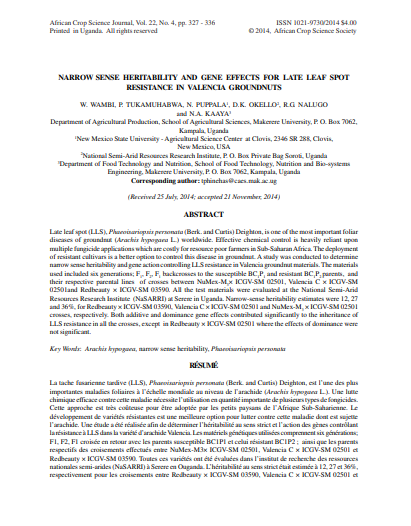Narrow sense heritability and gene effects for late leaf spot resistance in Valencia groundnuts
Summary
Late leaf spot (LLS), Phaeoisariopsis personata, is one of the most important foliar diseases of groundnut (Arachis hypogaea L.) worldwide. Effective chemical control is heavily reliant upon multiple fungicide applications, which are costly for resource poor farmers in sub-Saharan Africa. The deployment of resistant cultivars is a better option to control this disease in groundnut. A study was conducted to determine narrow sense heritability and gene action to control LLS resistance in Valencia groundnut materials. The materials used included six generations, F1, F2, F1 backcrosses to the susceptible BC1 P1 and resistant BC1 P2 parents, and their respective parental lines of crosses between NuMex-M3 × ICGV-SM 02501, Valencia C × ICGV-SM 02501, and Red beauty × ICGV-SM 03590. All the test materials were evaluated at the National Semi-Arid Resources Research Institute (NaSARRI) at Serere in Uganda. Narrow sense heritability estimates were 12, 27, and 36% for Red beauty × ICGV-SM 03590, Valencia C × ICGV-SM 02501, and NuMex-M3 × ICGV-SM 02501 crosses respectively. Both additive and dominance gene effects contributed significantly to the inheritance of LLS resistance in all the crosses, except in Red beauty × ICGV-SM 02501, where the effects of dominance were not significant.
Open resource Download resource Access resource on external site

